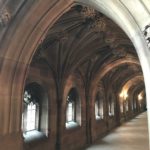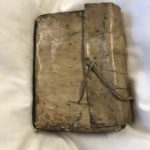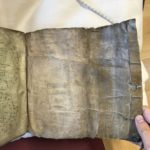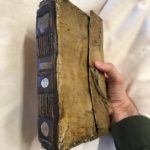
Blog-post author Sebastian Sobecki, Professor of Medieval English Literature and Culture, University of Groningen NL
The Latin narrative of Saewulf’s voyage to the Holy Land in 1102 is so significant because his account of Jerusalem is one of the first to have reached us after the city’s conquest in 1099 during the First Crusade. His report is therefore a remarkable snapshot of emerging Crusader Jerusalem – not unlike the Western rediscovery of this region through the industrial lense of the daguerreotype images from 1844 shown here – these are some of one of the first photographs taken of Jerusalem.
Saewulf’s report forms part of a small group of pilgrims’ accounts that mark the beginning of European an explosion in the production of itineraries and guidebooks to Palestine. His account and material practices therefore represent a notable point of comparison for accounts written by later pilgrims. Yet despite the significance of this text, little attention has been paid to Saewulf as a writing pilgrim.
This otherwise unidentified Englishman has left behind a remarkably detailed and informed account of his travels to Palestine and back. His voyage came only three years after the Crusaders’ conquest of Jerusalem, when demand for pilgrim transport was so high that he could not find a ship in southern Italy to cross the Mediterranean. Instead, he had to settle for an arduous coastal voyage along the Adriatic and through Greece.
In July 1102, Saewulf sailed from southern Italy for Jaffa, while his return voyage took him to Ereğli in Anatolia, where his narrative breaks off in September 1103.[1] We do not know, for that matter, whether he himself indeed returned to England. The text of Saewulf’s only known work has survived in a single manuscript, Cambridge, Corpus Christi College MS 111, a vellum and paper codex formerly owned by Archbishop Matthew Parker.[2] Saewulf’s Latin text has been written out in a twelfth-century hand and occupies pp. 37 (second column)-46 (second column). Nothing else is known about Saewulf, though he may have been the merchant Seuulfus of Worcester mentioned in William of Malmesbury’s Gesta pontificum Anglorum.[3]
I first came across this intriguing text when, many years ago, I surveyed insular works that engaged with the sea and maritime elements. Saewulf, despite his dedicated focus on spiritual destinations, offers two well-crafted voyage tales full of lively glimpses of a long-distance pilgrim’s life on the road: the account of his actual voyage to the Levant and back includes details that at times turn him into a proto-tourist, an engaged beholder of the strange world around him. Recently I returned to Saewulf, when annotating the text in translation for an anthology Anthony Bale and I are editing (Medieval English Travel: An Anthology (Oxford: Oxford University Press, 2018)). Our text is essentially a slightly updated and modernised version of the serviceable translation Thomas Wright published in 1848 in his milestone anthology Early Travels in Palestine.[4]
Although our text is based on Wright’s translation, unlike R.B.C. Huygens’ modern edition of the Latin text in the Corpus Christianorum series,[5] we have decided to gloss every place or locality, event, individual, and textual reference. As a result, I worked on the text with a map at my side, and it became clear to me that we can learn a great deal more about Saewulf’s library and his use of material sources during his visit to the Holy Land.
Most scholars believe that Saewulf’s account actually consists of three elements, that is, a guidebook to the Holy Land that is bookended by Saewulf’s reports of travelling to and returning from Jaffa[6]. While the two voyage narratives are thought to have been written or dictated by Saewulf, the embedded guidebook is usually assumed not to have been his work. And there seem to be good arguments for this surmise: unlike the first and third parts of the narrative, the guidebook is not written from a first-person perspective. Most of the guidebook’s passages are indeed impersonal, and many are derived from its primary source of information on Palestine, Bede’s eighth-century De locis sanctis / On the Holy Places. And there are further parallels between the guidebook embedded in Saewulf’s report and three existing texts of the same genre, commonly referred to as The First Guide, Qualiter, and The Ottobonian Guide, all three of which are roughly contemporary with Saewulf’s text, though in all probability precede his guidebook by less than a handful of years or even months.[7]
But on closer inspection, these guidebooks are much shorter than the report embedded in Saewulf; in fact, his text is longer and more detailed than all three of them put together. There is, I should add, no evidence that any of these three surviving guidebooks have been read by the author of Saewulf’s guidebook; on the other hand, the many verbatim echoes and details of Bede’s On the Holy Places clearly served as the basis for the text of Saewulf’s guidebook. On closer inspection, though, it seems to me that it was actually Saewulf who modified the existing guidebook (or a copy of Bede’s text) on-site in Palestine. The arrangement of his guidebook is such that, in the case of most paragraphs, a line or two with broad directions and biblical detail opens the account of a particular location, but this is then often followed by a contemporary update or impression. For instance, when introducing Jericho, Saewulf’s guidebook mirrors the skeletal account in the Ottobonian Guide by sharing with it the information on distance to Jerusalem and the reference to Elisha’s fountain before inserting a sentence not found in the Ottobonian Guide or in Bede for that matter: ‘The plain is indeed beautiful wherever you look’ (John Wilkinson, Joyce Hill, and W. F. Ryan, Jerusalem Pilgrimage 1099-1185 (Hakluyt Society, 1988), 109). Similarly, the description of Bethlehem opens with a sentence found in the Qualiter guide and contains information from Bede, before Saewulf’s guidebook adds: ‘Nothing habitable is left there by the Saracens, but it is all ruined, exactly as it is in all the other places outside the walls of Jerusalem’ (Jerusalem Pilgrimage 1099-1185, 108). Again, the same occurs when Saewulf’s embedded guidebook describes Nazareth. The prefatory material is mostly sourced from Bede, but then Saewulf’s text inserts the following update: ‘But the city of Nazareth is wholly ruined and all pulled down by the Saracens’ (Jerusalem Pilgrimage 1099-1185, 110).
To my mind, the emerging pattern is one of almost interlinear blocks where the authoritative biblical identification of a place is sourced from Bede, with Scriptural support, only to be followed by eyewitness corroboration and, more often than not, the contrasting contemporary state of dilapidation of the respective place. Using Ockham’s Razor, there is no reason to suppose that this latter information has been provided by another traveller who had just seen Palestine after the end of the First Crusade in time for Saewulf to have obtained access to this new knowledge. Instead, the guidebook section as it stands now was most probably updated and written by Saewulf himself. The specific pattern that I have described strongly suggests, in my opinion, that Saewulf had copied out from Bede and perhaps from another guidebook the basic and very brief identifications of the most important places in the Holy Land, to which he then added concise information on site. The brevity and conciseness of both components suggests a portable text, most likely a vellum quire, bound or otherwise.
Saewulf’s reading was of course wider than just Bede, and betrays a solid grounding in the Bible and patristic literature, primarily Jerome and some Augustine. I don’t want to speculate here whether Saewulf or someone writing for him had had access to a library in Palestine, so soon after the First Crusade. It is rather more likely that any such information, and access to physical books, came after his return to England. This includes consultation of the Vulgate, Jerome’s Sentences and his Liber de situ et nominibus locorum hebraicorum, as well as Boethius’ Consolation of Philosophy. But the manner in which Saewulf has modified the information his guidebook shares with Bede and similar texts may suggest that he took notes on site, and that he had with him a physical booklet into which he inserted his own additions.
The second observation I have made when annotating Saewulf’s account is that he inverts east and west on a few occasions. However, this only occurs when describing places outside of Jerusalem and when he introduces material not found in his sources and analogues. For instance, his topography of the wider area of the Sea of Galilee is confused. Saewulf does not say in which direction Galilee lies; he only states that it is three days from Jerusalem which corresponds to the information given in the First Guide. But Saewulf believes that Galilee is not only a lake but also a city, clearly departing here from his main source, Bede, and other surviving early guidebooks. More importantly, he places Nazareth east of Mount Tabor, on the sea of Galilee, instead of its actual location west of the mountain.
Saewulf’s difficulties arise with larger scale directions that involve travel planning. Locations within walking distance or those that he had actually visited are usually correctly placed. Once he reaches Nazareth, his description is relatively detailed and precise:
The city of Nazareth is entirely laid waste and overthrown by the Saracens, but the place of the annunciation of our Lord is indicated by a celebrated church. A clear fountain bubbles out near the city, still surrounded, as formerly, with marble columns and blocks, from which the child Jesus, with other children, often drew water for the use of his mother. From Nazareth we proceed about four miles to the east, to Mount Tabor, on which the Lord, having ascended it, transfigured himself openly before Peter, John, and James. The mountain is covered in an extraordinary manner with grass and flowers, and rises in the middle of the green plain of Galilee as to exceed in altitude all the mountains which, though at a distance, surround it. On the summit still remain three ancient churches.[8]
Another example concerns the monastery of St Saba. Writing about its location, Saewulf says that:
About three miles to the west of the church of the Holy Cross is a very fine and large monastery[9] in honour of St Sabbas,[10] who was one of the seventy-two disciples of our Lord Jesus Christ. There were above three hundred Greek monks living there, in the service of the Lord and of the Saint, of whom the greater part have been slain by the Saracens, and the few who remain have taken up their abode in another[11] monastery of the same Saint, within the walls of the city, near the tower of David, their other monastery being left entirely desolate.[12]
Mar Saba, the Holy Laura of St Sabbas the Sanctified, is actually in the West Bank, that is, in the opposite direction. Saewulf’s inversion of east and west could of course be accidental, the result of sloppiness or – worse – a cultivated lack of interest. However, throughout his account he endeavours to be reliable and accurate, especially where it concerns topographical detail, so such a series of mistakes would be uncharacteristic of Saewulf’s style. Furthermore, the pattern that emerges is not one of random mistakes, but of an inversion of the cardinal directions. East does not become north or south; the confusion is always an inversion. Even his phrasing of the location of Bethlehem six miles to the south of Jerusalem is sufficiently unclear to have made Thomas Wright translate the sentence by assigning to Bethlehem a northern direction.
Given this pattern, I would like to propose the possibility – offered here with all due caution – that Saewulf may have seen a map of the region with a southern orientation. I understand that this is a speculation, and I do not wish to estimate its probability here. We could of course point out that since the T-O world maps common in Latin Christendom were oriented toward the east, Saewulf would have needed to see a map with a western orientation in order to be diametrically confused, as it were. But T-O mappae mundi were either skeletal when they travelled in books – usually in copies of Isidore’s Etymologies – or they were enormous presentation objects displayed in selected cathedrals – in any case, they were not meant for travel, much less for travellers. Mediterranean and coastal travel relied on portolan charts, maps of ports and coastal landmarks to enable cabotage. Such maps were virtually exclusively oriented toward the north. Saewulf’s long and arduous voyage across the northern Mediterranean and Greece is detailed – so much so that it is usually considered to be the highlight of this entire account; aboard multiple vessels, Saewulf would have been able to view and study such maps. On arriving in Palestine, he had therefore the same geographical orientation as we do now – expecting a northern-oriented map. Seeing the opposite – a southern-orientation map – would explain his inversion of the cardinal directions.
As many of you will know, the majority of Islamic maps of the world – especially those following the Balkhi school, recently re-named the KMMS model by Karen Pinto[13] – are oriented toward the south [examples of such maps can be found here: Al-Idrisi’s Tabula Rogeriana, prepared for Roger II of Sicily only fifty years of Saewulf’s text, is also oriented toward the south:
![The Tabula Rogeriana, drawn by al-Idrisi for Roger II of Sicily in 1154. [Source: Wikimedia Commons]](http://www.bbk.ac.uk/pilgrimlibraries/wp-content/uploads/2017/12/sobecki-image-1.jpg)
No satisfactory explanation has been found for this phenomenon, though the most likely reason lies in pre-Islamic Arabic tradition, perhaps reinforced after the conversion to Islam by the location of Mecca and Medina in the southern part of the Arabian peninsula. As with Latin T-O or Beatus maps, it is not likely that Saewulf would have seen such learned books. Furthermore, KMMS-type maps share their macro-level zoom with T-O maps, and save for continents, some countries, and select cities, there is hardly anything of topographical relevance or use for Saewulf. However, more applicable and relevant were maps of the Levant and the Arabian peninsula, often designed for Muslim pilgrims on their way to Mecca. These maps were of the simplest kind, essentially not much more than itineraries superimposed on a rough geometrical shape. They were, however, oriented to the south. [I am specifically thinking here of the maps reproduced on pp. 118 and 124 in Gerald R. Tibbetts, ‘The Balkhi School of Geographers,’ in J.B. Harley and David Woodward, eds., History of Cartography, vol. II, Book 1: Cartography in the Traditional Islamic and South Asian Societies (Chicago: Chicago University Press, 1992), pp. 108—36 – viewable here:
We know that knowledge of Arabic was more widespread throughout the Crusader kingdom than was once assumed, and although the early Kingdom of Jerusalem was not a Cordoba or a Naples, there was nevertheless pragmatic exchange, and there were certainly Arabic-Latin translators (even the grossly exaggerated Middle English romance Richard Coer-de-Lyon has ships with translators – Latiners – on board). Simple itineraries or regional maps must have been valuable, and in the first months after the conquest of Jerusalem such maps, either drawn in Arabic or in Arabic and Latin, may have provided a useful tool for a pilgrim such as Saewulf.
Footnotes
[1] Saewulf’s routes are discussed in John H. Pryor, ‘The Voyages of Saewulf’, in Peregrinationes Tres: Saewulf, Iohannes Wirziburgensis, Theodericus, ed. R. B. Huygens, CETEDOC (Turnhout, Belgium: Brepols, 1995), 33–57.
[2] For a description of the manuscript, see M. R. James, A Descriptive Catalogue of the Manuscripts in the Library of Corpus Christi College, Cambridge, 1, vol. 1 (Cambridge: Cambridge University Press, 1912), 236–47.
[3] Peter Damian-Grint, ‘Sæwulf (fl. 1102–1103)’, in Oxford Dictionary of National Biography (Oxford: Oxford University Press, 2004). []
[4] Thomas Wright, ed., Early Travels in Palestine (London: Bohn, 1848).
[5] Peregrinationes Tres: Saewulf, Iohannes Wirziburgensis, Theodericus, ed. R. B. Huygens, CETEDOC (Turnhout, Belgium: Brepols, 1995).
[6] The established view on Saewulf’s use of guidebooks is best captured in Margaret Elizabeth Garnett’s remarkable BA dissertation, ‘“The Longed-for Place’: Saewulf and Twelfth-Century Pilgrimage to the Holy Land’ (BA thesis, College of William and Mary, 2000).
[7] These texts, together with Saewulf’s account, are available in modern translations issued by the Hakluyt Society: John Wilkinson, Joyce Hill, and W. F. Ryan, Jerusalem Pilgrimage 1099-1185 (Hakluyt Society, 1988).
[8] From Bale and Sobecki, ed., Medieval English Travel: An Anthology, forthcoming.
[9] monastery: Mar Saba, the Holy Laura of St Sabbas the Sanctified, is in the West Bank. Saewulf confuses east with west here.
[10] St Sabbas: St Sabbas the Sanctified (d. 532), Cappadocian-Syrian monk. Saewulf appears to be thinking of Cephas of Iconium, one of Christ’s seventy or seventy-two disciples.
[11] another … Saint: the metochion or branch of Mar Saba was indeed near the Tower of David (personal communication from Andrew Jotischky).
[12] From Bale and Sobecki, ed., Medieval English Travel: An Anthology, forthcoming.
[13] Karen C. Pinto, Medieval Islamic Maps: An Exploration (Chicago: University of Chicago Press, 2016).


![Image 1. Geoffrey Chaucer’s Physician on his way to Canterbury, from the Ellesmere Manuscript [Source: https://commons.wikimedia.org]](http://www.bbk.ac.uk/pilgrimlibraries/wp-content/uploads/2017/11/sickness1.png)
![Image 2. A medieval pharmacy depicted in the Tacuinum sanitatis, an illustrated herbal based on the "Taqwīm as‑siḥḥah" of Ibn Butlan. [Source: www.wikidoc.org]](http://www.bbk.ac.uk/pilgrimlibraries/wp-content/uploads/2017/11/sickmess2.jpg)
![Image 3. 'A snake attack'. British Library, Harley MS 3244, f.59v [Source: www.bl.uk/catalogues/illuminatedmanuscripts/]](http://www.bbk.ac.uk/pilgrimlibraries/wp-content/uploads/2017/11/sickness3.jpg)








